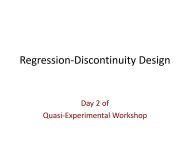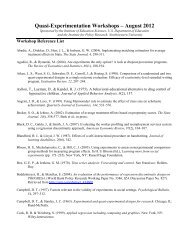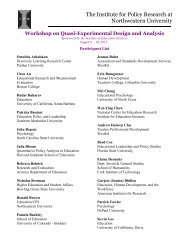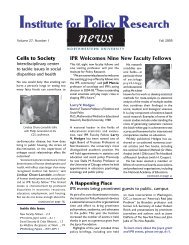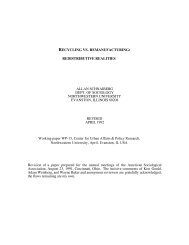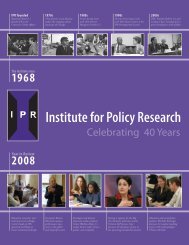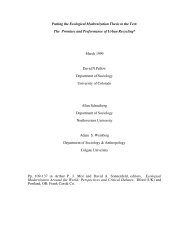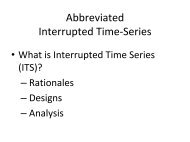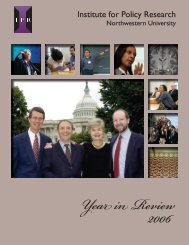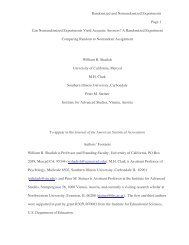Highlights of 2011 - Institute for Policy Research - Northwestern ...
Highlights of 2011 - Institute for Policy Research - Northwestern ...
Highlights of 2011 - Institute for Policy Research - Northwestern ...
Create successful ePaper yourself
Turn your PDF publications into a flip-book with our unique Google optimized e-Paper software.
Education <strong>Policy</strong><br />
IPR economist Diane Whitmore Schanzenbach points to how higher quality kindergarten classrooms, which include smaller class<br />
sizes and more effective teachers, can lead to better adult outcomes, including higher earnings.<br />
RESEARCH TOPICS:<br />
• School finance, accountability, and vouchers<br />
• Education interventions and program evaluations<br />
• Teacher and principal characteristics<br />
• Transitions from high school to college<br />
• Gaps in academic achievement<br />
Kindergarten Teachers and Future Pay<br />
Does it matter who your teacher is in kindergarten? In an innovative<br />
study, Diane Whitmore Schanzenbach, an IPR economist,<br />
and her colleagues at Harvard and the University <strong>of</strong> Cali<strong>for</strong>nia,<br />
Berkeley test whether kindergarten classroom quality<br />
and student test scores affect adult outcomes. They use 1980s<br />
data from the Tennessee Project STAR experiment, which randomly<br />
assigned nearly 12,000 children to kindergarten classes<br />
<strong>of</strong> varying sizes. The researchers then use tax data to link the<br />
students’ kindergarten class experience and test scores to adult<br />
outcomes, such as wages and education. Though the students’<br />
test-score boost from small class sizes and high-quality teachers<br />
tends to diminish later in elementary school, a substantial impact<br />
is found <strong>for</strong> a variety <strong>of</strong> adult outcomes. In particular, students<br />
randomly assigned to a higher quality kindergarten classroom<br />
earned more at age 30 and were more likely to own a home,<br />
be married, and have retirement savings than their kindergarten<br />
schoolmates assigned to a worse class. Showing that early classroom<br />
environments have a long-term impact not captured by<br />
standardized test scores, the researchers also point to the<br />
potential hazard <strong>of</strong> relying on such scores to evaluate longterm<br />
student achievement. Published in The Quarterly Journal <strong>of</strong><br />
Economics, the study was covered by The New York Times.<br />
Gains from Early Intervention<br />
In a working paper with Susan Dynarski and Joshua Hyman <strong>of</strong><br />
the University <strong>of</strong> Michigan, Schanzenbach examines the effects<br />
<strong>of</strong> reducing elementary school class sizes on college enrollment<br />
and getting a degree. Using Project STAR data, they find being<br />
randomly assigned to attend a smaller class in kindergarten<br />
through third grade increases the probability <strong>of</strong> attending<br />
college. Assignment to a small class increases the probability<br />
<strong>of</strong> attending college by 2.7 percentage points, with effects<br />
more than twice as large among African Americans. Among<br />
those with the lowest ex ante probability <strong>of</strong> attending college,<br />
the effect is 11 percentage points. In addition, small classes in<br />
the early grades improve the likelihood <strong>of</strong> earning a college<br />
degree and majoring in a more technical and high-earning<br />
field, such as a STEM field (science, technology, engineering,<br />
and mathematics), business, or economics. The paper points to<br />
the relationship between short- and long-term effects <strong>of</strong> an<br />
education intervention. More specifically, it documents shortand<br />
long-term effects <strong>of</strong> early education interventions. The<br />
actual long-run impacts were larger than what short-run test<br />
score gains alone would have predicted. This implies that costbenefit<br />
analyses based on short-run impacts might misestimate<br />
the true long-run effectiveness <strong>of</strong> interventions.<br />
29



